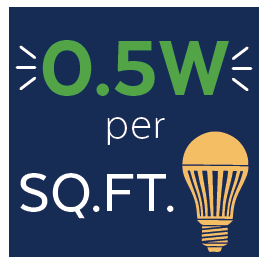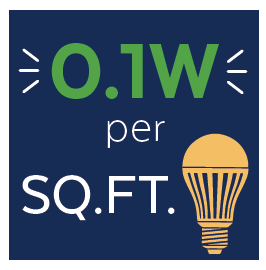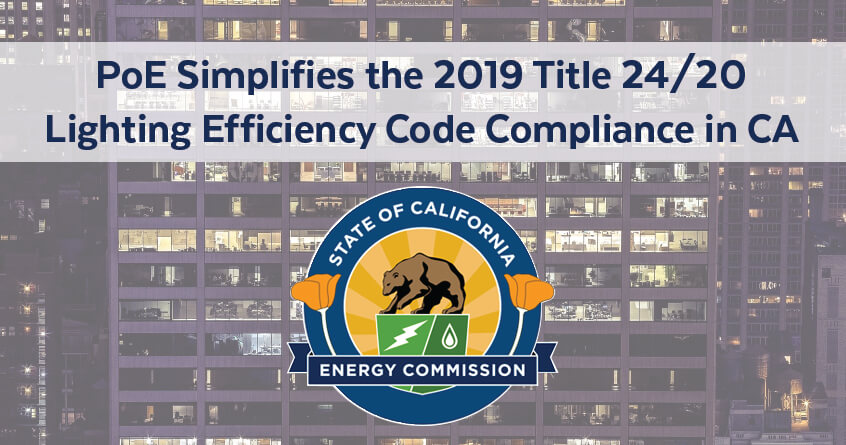Every few years, California releases its updated regulations on Title 20 and 24 for building energy efficiency for residential and nonresidential structures. These standards are helping occupants achieve lighting energy efficiency and savings. Though effective, these regulations are somewhat complicated to wade through. This post will endeavor to unpack the broader aspects of the latest version of California’s building-efficiency standards (2019).
For installers and contractors of PoE lighting, the 2019 update went into effect January 2020. It divides into two distinct categories: the Appliance Efficiency Regulations (Title 20) and Building Energy Efficiency Standards (Title 24, Part 6). Title 20 applies to the products at the point of sale (or as they arrive from the manufacturer.) Title 24 applies to compliance at the point of the new construction and building alteration. This focuses more on implementing products: how they turn off and on, energy levels to stay within code and more.
“Both work in tandem,” states Jasmine Shepard, an engineer for Energy-Solutions, “Supporting California’s lighting market transformation efforts.” Ms. Shepard presented a sample project to attendees in a recent presentation at Strategies in Light, an innovative lighting industry event held in San Diego, February 11-13, 2020. She is an expert in the codes and standards area, and uses her lighting and controls expertise to help clients identify the lighting features needed to meet these regulations.
2019 Standards Overview
The 2019 Building Energy Efficiency Standards improve upon the 2016 Energy Standards for new construction of, and additions and alterations to, residential and nonresidential buildings. Buildings permitted on or after January 1, 2020, must comply with the 2019 Standards.
NOTE: The California Energy Commission updates the standards every three years.
Energy budget
The Standards contain energy efficiency requirements for newly constructed buildings and additions and alterations to existing buildings. The California Energy Commission measures energy consumption in terms of how much of the energy budget is used per square foot of floor space. Thankfully, they’ve also given builders some flexibility in achieving this performance metric.
- The PRESCRIPTIVE OPTION allows builders the ability to comply by using methods known to be efficient.
- The PERFORMANCE OPTION allows builders to use design methods to achieve the same overall result.
Ultimately, energy efficiency is the goal and how a builder achieves it may align within the financial and physical constraints of that specific project. To simplify the process, California divides these standards into three basic sets.
Three sets of standards to make the compliance process flexible
ONE: a set of basic efficiency requirements that applies to all buildings.
TWO: a set of performance standards – the energy budgets – that vary by climate zone and building type. These tailor to local conditions, and provide flexibility in how to achieve energy efficiency in buildings.
THREE: a final set of prescriptive packages that provide a recipe or a checklist compliance approach.
Each of these approaches provides a sound basis for achieving compliance while allowing the people on a particular project room for creativity. One technology that is helping simplify the process is Power over Ethernet (PoE) connected lighting managed over lighting platforms.
PoE allows lighting to receive power and data through one Cat5e, Cat6 or Cat6A Ethernet cable. Smart lighting not only helps with standard efficiency requirements but also allows designers and contractors to meet these performance standards and compliance checklists within budget.
The allowed wattage levels for things like egress lighting and such continue to drop. A lighting platform delivering power and data may be programmed to permissible levels automatically through multi-layered control systems.
This technology provides the flexibility needed to achieve short term goals and repurpose existing equipment to be replaced at reasonable end-of-life (EoL) intervals. Compliance is easier and energy is saved. PoE is definitely a green option.
Mandatory lighting controls
The sections of the 2019 Efficiency Standards that pertain to mandatory lighting controls [SECTION 130.1,2, NA 7.6], divide into indoor and outdoor. They further divide into manual and automated controls.
Access to controls
Multi-level lighting controls must also include manual access in areas like restrooms and corridors with separate platform controls for each floor, not counting stairwells.
The code also requires the ability to achieve multiple levels of light, for instance, up to 0.5W per square foot during off-peak while higher during business hours. The code further requires lights to be able to jump to multiple pre-setting levels of intensity accessible within the 24-hour period depending upon occupancy. They must also include automatic shut off when sensors do not pick up the presence of people during off-peak times.
Sensors
Sensors shut off controls automatically to reduce lighting power when spaces are typically unoccupied while kicking on in case of emergency when normal power is absent due to outages. Smart technologies needed here would be:
- Occupant sensing controls
- Automatic time-switch controls
- Automatic shut-offs
Up to 0.1W per square foot of lighting within a building may remain on provided that area is designated for exiting the building.
Partial-on light settings are within 50-70 percent of normal work settings.
PoE solution: each and every one of these settings and configurations may be programmed into a lighting platform and automated. At the end of the day, unless an occupant needs to touch a light switch, that person isn’t going to want to have to deal with the light levels.
Ornamental lighting
Another facet covered in the 2019 Efficiency Standards is controls for displays and display cases, and ornamental lighting. These need to put on automatic time switches while still allowing manual-on mode.
PoE lighting solutions make all of this management easier
Amidst all of these particulars, the code asks building managers to maintain uniform lighting levels throughout their facilities. From classrooms to libraries, warehouses to parking garages–one step between low and high lighting is required. Having smart lights allows systems to be automated and remotely accessed by authorized personnel.
Keep in mind that once these systems are installed they must also be tested, scheduled and periodically time corrected to assure that occupants are safe in the event of an emergency. When you’re dealing with this many variables, having PoE at your fingertips makes sense.
Feel free to contact us and learn how our range of PoE networking technologies can help support the compliance of your California new build, addition or renovation.

